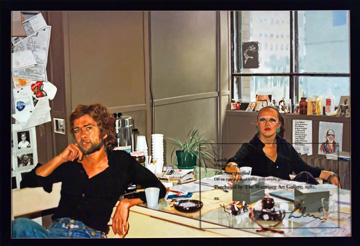 Click here to read an essay by Robert Epp. Click here to read an essay by Dr. Jeanne Randolph. Click here to read an essay by Cliff Eyland. Click here to see a list of works in the exhibition. Click here to view images of Gordon Lebredt's work. Click here for a commentary by Robert Epp on Gordon Lebredt's "white walls:black holes" Click here for an addendum by Gordon Lebredt on his "white walls:black holes" Click here for images by Gordon Lebredt from "white walls:black holes"
|
<  >
>ABOVE: Gordon Lebredt, Title: not specified . Photo credit: Ernest Mayer. (Note: To navigate please click arrows or image.) 04 Title: not specified 1974-75 / 2005 oil on canvas 159.2 x 238.7 cm Collection of the Winnipeg Art Gallery; Acquired with funds from The Winnipeg Foundation (G-82-66) Like Epokhé, Title: not specified was only finished in 2005 with the addition of the acrylic sheeting with the vinyl title block, and the mounting of the painting in a four-part frame, similar to Epokhé. Upon completion, Lebredt attached the following text to the back of the painting: Adding, here, nothing that the frame won't hold-upon its falling away. The painting is based on a photograph taken by Lebredt of Doug Sigurdson and Suzanne Gillies, co-founders of Plug In Gallery, Winnipeg in 1972. Lebredt made the painting by first covering the blank canvas with a piece of craft paper gridded off into sections. He then cut out one square of the paper and painted in the area that corresponded to the gridded source photograph. After the painted area had dried, he replaced the paper square and moved on to the next square, applying the same process for the painting of the entire work. This restriction demanded that Lebredt complete the entire painting without seeing the work as it progressed. The finished painting was only revealed after all the squares were done. Again, Lebredt wanted to emphasize programme, or technicity, with respect to what otherwise would appear as a more or less seamless painterly event. |